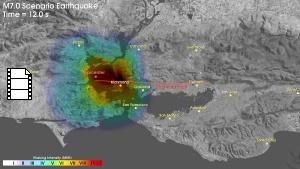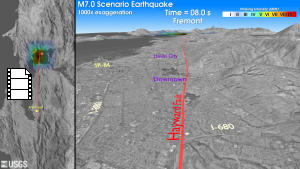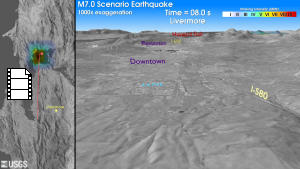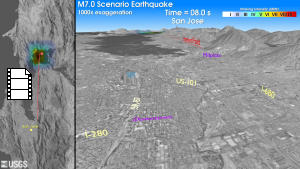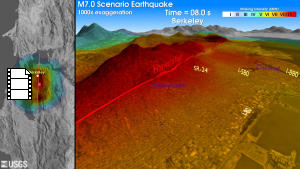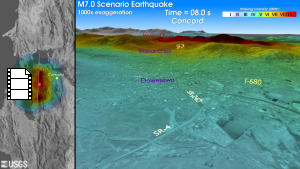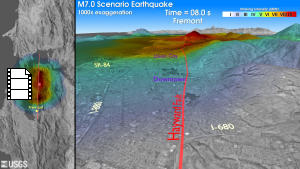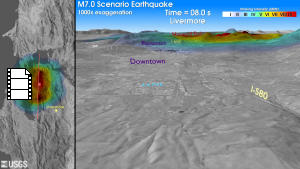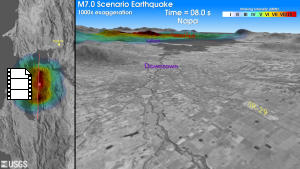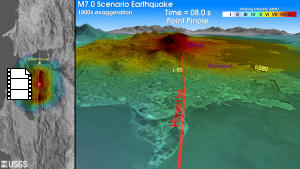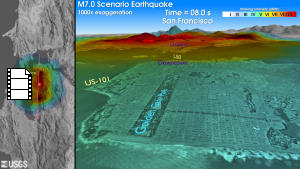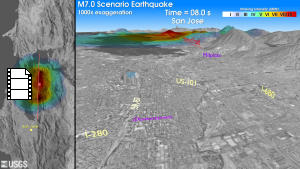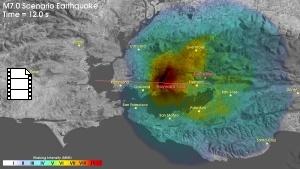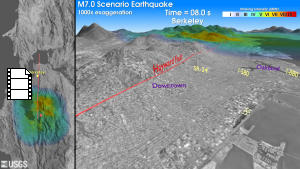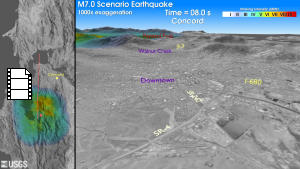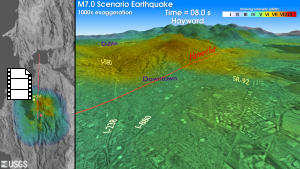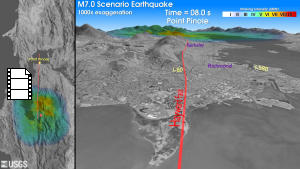These three scenarios show the ground shaking for a magnitude 7.0 earthquake on the Hayward fault. Similar to the magnitude 6.8 scenarios, the slip or offset across the fault is the same in all three cases, but the earthquake ruptures start in different locations, in this case, San Pablo Bay, Oakland, and Fremont. These scenarios are larger than the magnitude 6.8 1868 earthquake but are about as likely to occur as the magnitude 6.8 scenarios because there has not been a large earthquake on the northern portion of the Hayward fault for about 300 years.
These scenario earthquakes rupture 52 miles (83 km) of the Hayward fault extending from Fremont to San Pablo Bay. The average slip or offset across the fault is about 4 ft (1.3 m). Compared to the magnitude 6.8 scenarios, these magnitude 7.0 scenarios have a longer rupture length and larger average slip. This results in significantly stronger shaking.
San Pablo Bay Epicenter
Map View
Detailed Perspective Views

The detailed, perspective views show the ground shaking from a viewpoint two miles (three kilometers) above the earth looking towards each location. In each movie the left panel shows a map view of the area with the fault highlighted in red, the epicenter (location where the rupture starts) identified by the red ball, and the location shown in the right panel labeled in yellow. In the right panel the deformation of the ground associated with the propagation of the seismic waves is exaggerated by a factor of 1000. The topography has been exaggerated by a factor of four to make the hills and mountains more readily visible.
Click on the map to view the normal resolution movie for that location. HD versions are available below.
The ground moves 18-24 inches (0.3-0.6 m) at locations along the fault. In Livermore the sedimentary basin amplifies the motions so that the maximum displacement is 3.5 ft (1 m).
The colors indicate the peak intensity of the shaking up to the current time in the movie at each location. See Explanation of Colors for a more detailed description of the color scheme.
The movies are available in two different resolutions. The normal resolution versions are typically 10 MB in size. The high definition (HD) versions are typically 30 MB in size and are best viewed on high resolution displays.
These images and movies are in the public domain and may be used freely. Please credit the U.S Geological Survey.
Oakland Epicenter
Map View
Detailed Perspective Views

The detailed, perspective views show the ground shaking from a viewpoint two miles (three kilometers) above the earth looking towards each location. In each movie the left panel shows a map view of the area with the fault highlighted in red, the epicenter (location where the rupture starts) identified by the red ball, and the location shown in the right panel labeled in yellow. In the right panel the deformation of the ground associated with the propagation of the seismic waves is exaggerated by a factor of 1000. The topography has been exaggerated by a factor of four to make the hills and mountains more readily visible.
Click on the map to view the normal resolution movie for that location. HD versions are available below.
The ground moves 18-24 inches (0.3-0.6 m) at locations along the fault. In Livermore the sedimentary basin amplifies the motions so that the maximum displacement is 2 ft (0.6 m).
The colors indicate the peak intensity of the shaking up to the current time in the movie at each location. See Explanation of Colors for a more detailed description of the color scheme.
The movies are available in two different resolutions. The normal resolution versions are typically 10 MB in size. The high definition (HD) versions are typically 30 MB in size and are best viewed on high resolution displays.
These images and movies are in the public domain and may be used freely. Please credit the U.S Geological Survey.
Fremont Epicenter
Map View
Detailed Perspective Views
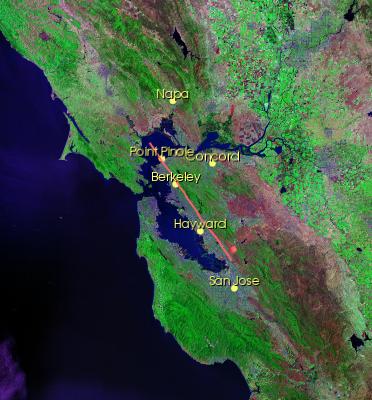
The detailed, perspective views show the ground shaking from a viewpoint two miles (three kilometers) above the earth looking towards each location. In each movie the left panel shows a map view of the area with the fault highlighted in red, the epicenter (location where the rupture starts) identified by the red ball, and the location shown in the right panel labeled in yellow. In the right panel the deformation of the ground associated with the propagation of the seismic waves is exaggerated by a factor of 1000. The topography has been exaggerated by a factor of four to make the hills and mountains more readily visible.
Click on the map to view the normal resolution movie for that location. HD versions are available below.
In Berkeley and Hayward the ground moves about 2-3 ft, while in San Jose and Napa the ground moves only about 1 ft.
The colors indicate the peak intensity of the shaking up to the current time in the movie at each location. See Explanation of Colors for a more detailed description of the color scheme.
The movies are available in two different resolutions. The normal resolution versions are typically 10 MB in size. The high definition (HD) versions are typically 30 MB in size and are best viewed on high resolution displays.
These images and movies are in the public domain and may be used freely. Please credit the U.S Geological Survey.
« Back
 Jump to Navigation
Jump to Navigation
